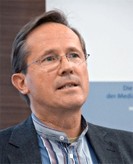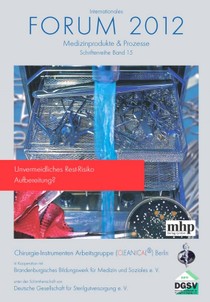Archived contributions of recent years
- archive 2018 - From the Editorial (FORUM PanAmericano No.3)
 Medical devices (MD) and processes belong together, that was the idea of the FORUM, since we started the event in 1999. In 2016, we launched the FORUM PanAmericano, a bilingual journal, that takes into account that Spanish is the most widely used language on the American continents and English is the language that is understood by most of the people worldwide. This concept might get adapted for other parts of the world, mainly in order to support 3 ideas:
Medical devices (MD) and processes belong together, that was the idea of the FORUM, since we started the event in 1999. In 2016, we launched the FORUM PanAmericano, a bilingual journal, that takes into account that Spanish is the most widely used language on the American continents and English is the language that is understood by most of the people worldwide. This concept might get adapted for other parts of the world, mainly in order to support 3 ideas:- The discussion about what is right and what seems wrong
- Education for skilled staff, providing adequate information globally
- Practice of common processing standards on an adequate level of preventive measurements (“hygiene”)
Now the 20th anniversary is coming up for our efforts in opinion building, information and promotion of innovative ideas like
- Cleaning as the most effective part of disinfection (reduction of viable microorganisms by removal of remnants)
- Just in time measurement of physical parameters (p, t, T, pH, µS) with data loggers (instead of endpoint determination by colorimetric indicators)
- Focusing on luminal instruments as they are used in minimally invasive surgery (MIS) or flexible endoscopy (how critical is processing)
- Determination of standard operating procedures (SOP)
Since then, we have seen a development from mere „sterilization“ to „processing“ and now to the practice of risk management
What is a medical device – and why?
As a matter of fact, a surgeon can use any sort of instrument or tool for his operation, if he believes it is adequate for his technique. It is his responsibility, and he has to account for its appropriateness. It may be a sharp knife or a hammer in an emergency, or a specific tray. Is that the state of the art, or even adequate? In fact, we occasionally notice that surgeons are not always aware of all the needs and regulatory affairs in connection with medical devices and concerning processes. In Europe, for example, we recently got a new Medical Device Regulation (MDR) which comprises (depending on the national language) some 300 pages, leaving plenty of space for interpretations.
Disposable MD must work the way they are supposed to and for this, they have to be cleaned from residues of the production, then packed and sterilized and shipped off for clinical use. Reusable MD equally must be processed in such a way that they work for each patient as if he were the first. Disinfection is not cleaning, but cleaning might have a disinfecting effect, namely the reduction of viable microorganisms (which is more than biocidal “killing” action).
Risk management as crucial part of the quality management
A stepwise (parametric) release of the structured processes is required following “standard operation procedures” (SOP). Such risk management is installed to prevent undesirable “events”, to give no “evidence” to incidents
that endanger patients, staff or third parties (Fig. 1).
Uncritical, semi-critical, critical: 3 risk classes (annex VIII) are deemed for evaluation of the risks for patients, aimed at the manufacturer, clinical user and the control authorities. The traditional Spaulding-Classification was adapted by various hygiene recommendations and guidelines. With a view to the design of the MD, the categories A, B, C were added with regard to sterilization (mainly the capability to withstand steam sterilization).
Thermostability/-lability was the criterion for B shifting to C, moreover cleanability with the shift from A to B. Categorizing MD was meant to lower the risks associated with unsuitable processing techniques. It also means that we need to have confidence in the competence of the processing staff and their skills.
Dr. med. Dipl. Ing. Thomas W. Fengler
Chirurgie-Instrumenten-AG Berlin
- archive 2015
Dr. Thomas W. Fengler at BVMed-Hygieneforum 2015
Topic: "Nosocomial Infections"
 "Hospital hygiene remains a key challenge in the German health care system and will in the future play a major role in the quality measurement of clinics. The avoidance of hospital infections should not rely on individual actions, but use and implement bundling strategies. This was the consensus of the experts at the 4th BVMed Hygiene Forum "Prevention of Nosocomial Infections" on 2nd December 2015 in Berlin, with more than 100 participants."
"Hospital hygiene remains a key challenge in the German health care system and will in the future play a major role in the quality measurement of clinics. The avoidance of hospital infections should not rely on individual actions, but use and implement bundling strategies. This was the consensus of the experts at the 4th BVMed Hygiene Forum "Prevention of Nosocomial Infections" on 2nd December 2015 in Berlin, with more than 100 participants."Our presentation dealt with KRINKO 2012 (a guideline on hygiene in the processing of medical devices). Quote from the press release of BVMed: "Fengler urged for greater simplicity and clarity of the recommendation and suggested to shift the focus on possible risks in part, for example on the subject of Tuberculosis. As a "central document preparation" KRINKO 2012 had special significance. For this reason, he suggested republishing this important recommendation after didactic reduction."
- archive 2012
"Residual risk of processing "practice" ? (article, June 2012)
What can be described, what must be described? File folders full of paper as a consequence of the validation process are a heavy (!) burden on sterile supply departments all over and hinder their productive work. We speak here as experienced validators with hundreds of process-validations about the common practice of documentation ("30 years ...")
 Volume 15 of our international series "Medical Devices & Processes" with the topic "Residual Risk Processing?" will draw attention to all that is being filed. And we will demand sound judgement in regard to the required "formal" services, hampering the productive processing work. How successfull can efforts towards qualitative enhancements in the quality cycle of processing really be, if they consist primarily of filling paper? What kind of security do we gain here? Improvement requires creativity, not administration.
Volume 15 of our international series "Medical Devices & Processes" with the topic "Residual Risk Processing?" will draw attention to all that is being filed. And we will demand sound judgement in regard to the required "formal" services, hampering the productive processing work. How successfull can efforts towards qualitative enhancements in the quality cycle of processing really be, if they consist primarily of filling paper? What kind of security do we gain here? Improvement requires creativity, not administration.It is in the true sense of the word, a "growing" problem. Take, for example, the case of an employee of ours, reporting on his return from a process validation. Among other things, the Annex to the german ‘packaging guidelines’ were used. Puzzled, he noted that the downloaded and printed out pdf-file had to be hand-edited - as in the 20th century - with Tippex (in order to clear the entry fields of the pre-filled examples) before any data can be filled in. Or they have to be handcopied and tables with diagrams be crafted into them, using scissors and glue. Just look for example Annex B7 in the 'packaging guideline'.
Technical annexes must be provided to the user as fillable documents!
This applies to other areas of process validation, too. Why are the relevant documents not accessible online, already pre-formulated where possible and fillable where necessary? Or even: Why not a complete validation protocol? That should not be "superior knowledge", but consensus among experts.
Without going into the details of the contents, we would also like to indicate the non-editable "Recommendation for the Validation and Routine Control of Sterilization Processes with Saturated Steam for Medical Devices" (DGHK - July 2009): Appendix 3 Part 1 has 14 pages with tables, for example, Part 2 at least 9 pages, part 3 another 11.
For several questions, clarifications on the expected answer would be welcome: do we, for instance, fill in the supplier or the manufacturer (who is not always known) under “put in circulation by …”?
A remedy is demanded here, even in the standardization work. Finally, if a facility takes care of process validation responsibly, this must be achievable in an appropriate manner without file folders being filled by the meter - which is happening, unfortunately! Think of the bulky maintenance reports for each machine: an average hospital with 600 beds produces at least 10 full file folders per year, only for validations… which they would certainly prefer not to have to store for 30 years…
Would it not make sense to start a new process validation with an inventory sheet, where the results of previous validations are filled in, rendering the old shets redundant? The old results remain "noted", but just as with the BD test, the measurement and other protocols can go to the waste bin, the CD in the yellow bin. Mind you, in case of previous findings, these would have to be described.
You have your own views on the subject or further suggestions for ‘waste reduction’? Then please get in contact !
Yours sincerely,
Dr. Thomas W. Fengler
Surgical Instruments Workgroup Berlin
Cleanical Investigation & Applicationy
"The trouble with quality guidelines" (article: February 2012)
Some thoughts on Volume 14 of our series "International FORUM Medical Devices & ProcessesEndless paperwork might be the first association popping up in some people’s heads, and not without reason. Obviously, the task of reprocessing medical devices has seen some serious restructuring in the past decades. In the 60’s and 70’s the existence of a Central Sterile Supply Department (CSSD) in a hospital, especially if equipped with up-to-date machines, was enough to be content with. These days CSSDs are considered to be something of a production line for sterilty of medical devices to be used on the next patient.
Procedual instructions come in the form of written-down „Standard Operating Procedures“ (SOP), their execution is constantly being monitored and documented. Optimally, a quality management system has been implemented, as demanded by the social code and the recommendation of Robert-Koch-Institute (RKI, the authoritative instiution in Germany as far as all things hygienic are concerned). In that case there will probably be a guideline, referring to EN ISO 9000 and/or EN ISO 13485.
The labour of reprocessing medical devices is seen from the angle of quality management, hence he term guide(line). The central approach of our 14th booklet “FORUM Medizinprodukte & Prozesse" will be to weigh the effort of clarification of the involved processes against the sheer information flood that is rolling towards (and sometimes over) the staff.
Consider the new German guideline for washer-disinfectors: the problem is that this guide has been devised in a joint effort by several of the authoritative institutions in the field, in an attempt to reach an agreement by consensus. One can see how hard it must have been to include whatever was most important to each party while remaining on a common ground - too much is not enough!
Also new is the guideline for the validation of packaging processes, so looking at it from the point of view of a reprocessor will be another topic of the booklet: “Implementing the DGSV-Packaging-guideline in a CSSD”. And, “Will data loggers soon replace chemical and bio-indicators?”, is also a question worth dealing with. Yet another focus will be on specific functions of medical device reprocessing, like typical problems packing sterile goods in containers or soft packaging, and selection criteria for one or another form of package for surgical instruments.
There will, of course, be an experience report on validation and an outline for a QM-manual will round up our volume.
And last not least we shall think about and try to improve on the consistent and uniform usage of terms: do we say charging cart or mobile injector unit or loading trolley?
 And as far as abbreviations are concerned: there is still no glossary in the AKI’s “Red Brochure” (www.a-k-i.org). And what does IQ – OQ and PQ stand for anyway?
And as far as abbreviations are concerned: there is still no glossary in the AKI’s “Red Brochure” (www.a-k-i.org). And what does IQ – OQ and PQ stand for anyway?yours sincerely, Thomas W. Fengler
- archive 2011
Surgical Instruments Workgroup Berlin informs:
Operators watch out! ... on the shutdown of several german hospital CSSDs (in Kassel, Fulda, Munich):
Comment:What we need urgently right now are clear-cut criteria for shutdowns of central sterile supply departments. The current practice of shutdowns by the regional control authorities appears rather arbitrary in some respects and raises questions on the effects: insecurity of patients, considerable costs for hospital and society and hard-to-assess achievements in respect to hygiene. There is reason to fear that a climate of denunciation may prevail.Sincerely, Dr. Thomas W. Fengler
- archive 2010
“Life is a journey not a destination“
Our dear friend, teammate and co-founder of Surgical Instuments Workgroup Berlin, Helmut Pahlke, has passed away on 9/30/2010.
Media contributions "Treatment and handling of medical devices"
There is still no independent course of studies on “Processing and handling of medical devices“, state recognized qualification guarantees that the staff of the central sterile supply departments (CSSD) of the 2000 german hospitals possess a comparable level of education.  TV-Report "Report München"; ARD : "Reprocessing of Medical Devices” (video available only in german)
TV-Report "Report München"; ARD : "Reprocessing of Medical Devices” (video available only in german)
Every day innumerable instruments are disassembled, cleaned, disinfected, examined and maintained, packed including accessories and subjected to the sterilisation process.
Two current reports on the problem, in view of recent events (in German):